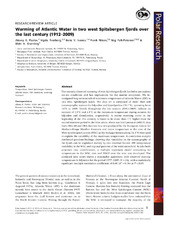Warming of Atlantic Water in two west Spitsbergen fjords over the last century (1912-2009)
Pavlov, Alexey K.; Tverberg, Vigdis; Ivanov, Boris; Nilsen, Frank; Falk-Petersen, Stig; Granskog, Mats A.
Peer reviewed, Journal article
Published version
Permanent lenke
https://hdl.handle.net/1956/10055Utgivelsesdato
2013-05-06Metadata
Vis full innførselSamlinger
- Geophysical Institute [1228]
Originalversjon
https://doi.org/10.3402/polar.v32i0.11206Sammendrag
The recently observed warming of west Spitsbergen fjords has led to anomalous sea-ice conditions and has implications for the marine ecosystem. We investigated long-term trends of maximum temperature of Atlantic Water (AW) in two west Spitsbergen fjords. The data set is composed of more than 400 oceanographic stations for Isfjorden and Grønfjorden (78.1°N), spanning from 1876 to 2009. Trends throughout the last century (1912–2009) indicate an increase of 1.9°C and 2.1°C in the maximum temperature during autumn for Isfjorden and Grønfjorden, respectively. A recent warming event in the beginning of the 21st century is found to be more than 1°C higher than the second warmest period in the time series. Mean sea-level pressure (MSLP) data from ERA-40 and ERA-Interim data sets produced by the European Centre for Medium-Range Weather Forecasts and mean temperature in the core of the West Spitsbergen Current (WSC) at the Sørkapp Section along 76.3°N were used to explain the variability of the maximum temperature. A correlation analysis confirmed previous findings, showing that variability in the oceanography of the fjords can be explained mainly by two external factors: AW temperature variability in the WSC and regional patterns of the wind stress field. To take both processes into consideration, a multiple regression model accounting for temperature in the WSC core and MSLP over the area was developed. The predicted time series shows a reasonable agreement with observed maxima temperature in Isfjorden for the period 1977–2009 (N=24), with a statistically significant multiple correlation coefficient of 0.60 (R2=0.36) at P<0.05.
Utgiver
Norwegian Polar InstituteCo-Action Publishing

